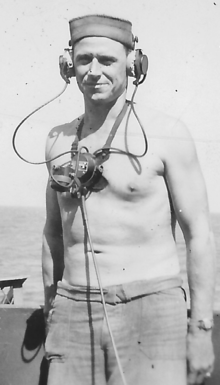
A telephone, colloquially referred to as a phone, is a telecommunications device that permits two or more users to conduct a conversation when they are too far apart to be easily heard directly. A telephone converts sound, typically and most efficiently the human voice, into electronic signals that are transmitted via cables and other communication channels to another telephone which reproduces the sound to the receiving user. The term is derived from Ancient Greek: τῆλε, romanized: tēle, lit. 'far' and φωνή, together meaning distant voice.

In telecommunications, an acoustic coupler is an interface device for coupling electrical signals by acoustical means—usually into and out of a telephone.
A communications system or communication system is a collection of individual telecommunications networks systems, relay stations, tributary stations, and terminal equipment usually capable of interconnection and interoperation to form an integrated whole. The components of a communications system serve a common purpose, are technically compatible, use common procedures, respond to controls, and operate in union.
In telephony, ringdown is a method of signaling an operator in which telephone ringing current is sent over the line to operate a lamp or cause the operation of a self-locking relay known as a drop.

Headphones are a pair of small loudspeaker drivers worn on or around the head over a user's ears. They are electroacoustic transducers, which convert an electrical signal to a corresponding sound. Headphones let a single user listen to an audio source privately, in contrast to a loudspeaker, which emits sound into the open air for anyone nearby to hear. Headphones are also known as earphones or, colloquially, cans. Circumaural and supra-aural headphones use a band over the top of the head to hold the drivers in place. Another type, known as earbuds or earpieces, consists of individual units that plug into the user's ear canal; within that category have been developed cordless air buds using wireless technology. A third type are bone conduction headphones, which typically wrap around the back of the head and rest in front of the ear canal, leaving the ear canal open. In the context of telecommunication, a headset is a combination of a headphone and microphone.
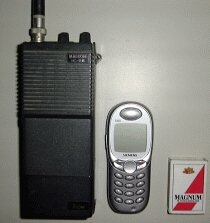
A radiotelephone, abbreviated RT, is a radio communication system for conducting a conversation; radiotelephony means telephony by radio. It is in contrast to radiotelegraphy, which is radio transmission of telegrams (messages), or television, transmission of moving pictures and sound. The term is related to radio broadcasting, which transmit audio one way to listeners. Radiotelephony refers specifically to two-way radio systems for bidirectional person-to-person voice communication between separated users, such as CB radio or marine radio. In spite of the name, radiotelephony systems are not necessarily connected to or have anything to do with the telephone network, and in some radio services, including GMRS, interconnection is prohibited.
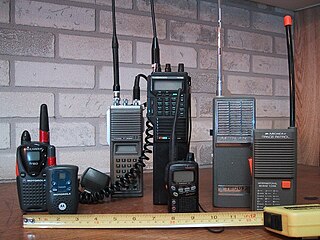
A walkie-talkie, more formally known as a handheld transceiver, HT, or handheld radio, is a hand-held, portable, two-way radio transceiver. Its development during the Second World War has been variously credited to Donald Hings, radio engineer Alfred J. Gross, Henryk Magnuski and engineering teams at Motorola. First used for infantry, similar designs were created for field artillery and tank units, and after the war, walkie-talkies spread to public safety and eventually commercial and jobsite work.
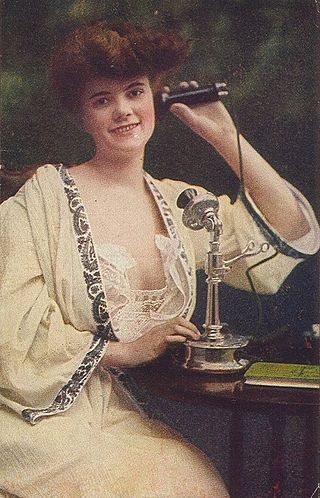
A telephone call or telephone conversation, also known as a phone call or voice call, is a connection over a telephone network between the called party and the calling party. Telephone calls started in the late 19th century. As technology has improved, a majority of telephone calls are made over a cellular network through mobile phones or over the internet with Voice over IP. Telephone calls are typically used for real-time conversation between two or more parties, especially when the parties cannot meet in person.
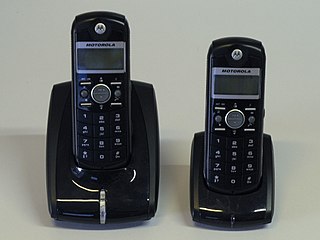
A cordless telephone or portable telephone has a portable telephone handset that connects by radio to a base station connected to the public telephone network. The operational range is limited, usually to the same building or within some short distance from the base station.
A speakerphone is a telephone with a microphone and loudspeaker provided separately from those in the handset. This device allows multiple persons to participate in a conversation. The loudspeaker broadcasts the voice or voices of those on the other end of the telephone line, while the microphone captures all voices of those using the speakerphone. The term speakerphone is also sometimes used for loudspeaker, as in "put it on speakerphone".

A business telephone system is a telephone system typically used in business environments, encompassing the range of technology from the key telephone system (KTS) to the private branch exchange (PBX).
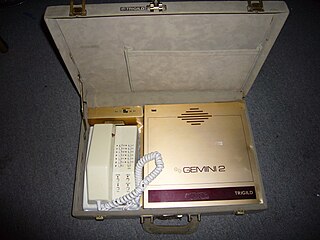
The Improved Mobile Telephone Service (IMTS) was a pre-cellular VHF/UHF radio system which linked to the public telephone network. IMTS was the radiotelephone equivalent of land dial phone service. Introduced in 1964, it replaced Mobile Telephone Service (MTS) and improved on most MTS systems by offering direct-dial rather than connections through a live operator, and full-duplex operation so both parties could talk at the same time.

An intercom, also called an intercommunication device, intercommunicator, or interphone, is a stand-alone voice communications system for use within a building, small collection of buildings or portably within a small coverage area, which functions independently of the public telephone network. Intercoms are generally mounted permanently in buildings and vehicles, but can also be detachable and portable. Intercoms can incorporate connections to public address loudspeaker systems, walkie talkies, telephones, and other intercom systems. Some intercom systems incorporate control of devices such as signal lights and door latches.
Plantronics, Inc. is an American electronics company producing audio communications equipment for business and consumers. Its products support unified communications, mobile use, gaming and music. Plantronics is headquartered in Santa Cruz, California, and most of its products are produced in China and Mexico.
A duplex communication system is a point-to-point system composed of two or more connected parties or devices that can communicate with one another in both directions. Duplex systems are employed in many communications networks, either to allow for simultaneous communication in both directions between two connected parties or to provide a reverse path for the monitoring and remote adjustment of equipment in the field. There are two types of duplex communication systems: full-duplex (FDX) and half-duplex (HDX).

This history of the telephone chronicles the development of the electrical telephone, and includes a brief overview of its predecessors. The first telephone patent was granted to Alexander Graham Bell in 1869.

Mobile radio or mobiles refer to wireless communications systems and devices which are based on radio frequencies, and where the path of communications is movable on either end. There are a variety of views about what constitutes mobile equipment. For US licensing purposes, mobiles may include hand-carried,, equipment. An obsolete term is radiophone.

A headset is a combination of headphone and microphone. Headsets connect over a telephone or to a computer, allowing the user to speak and listen while keeping both hands free. They are commonly used in customer service and technical support centers, where employees can converse with customers while typing information into a computer. They are also common among computer gamers and let them talk with each other and hear others while using their keyboards and mice to play the game.

The candlestick telephone is a style of telephone that was common from the late 1890s to the 1940s. A candlestick telephone is also often referred to as a desk stand, an upright, or a stick phone. Candlestick telephones featured a mouthpiece (transmitter) mounted at the top of the stand, and a receiver (earphone) that was held by the user to the ear during a call. When the telephone was not in use, the receiver rested in the fork of the switch hook protruding to the side of the stand, thereby disconnecting the audio circuit from the telephone network.

The Western Electric hand telephone sets are a series of telephones that were produced from 1927 by the Western Electric Company for the American Telephone and Telegraph Company (AT&T) and the Bell System. The series features the mouthpiece (transmitter) and the earpiece (receiver) combined into a hand-held unit, originally named a hand telephone, or handset. The handset would be held against the ear and in front of the mouth simultaneously, in contrast to earlier telephones in the Bell System where only the receiver was held against the ear, while the user spoke into a fixed transmitter mounted on a telephone stand or wall telephone.

